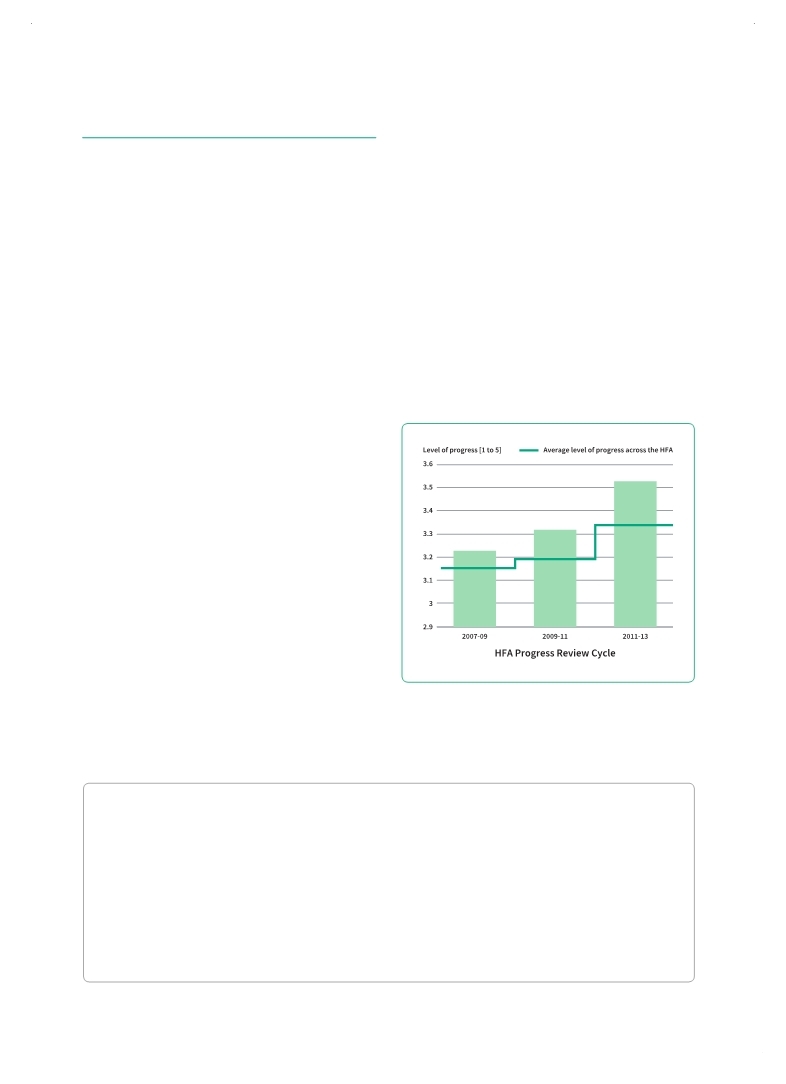 |
Global Assessment Report on Disaster Risk Reduction 2015
Making development sustainable: The future of disaster risk management |
 |
Global Assessment Report on Disaster Risk Reduction 2015
Making development sustainable: The future of disaster risk management |
|
|

236
Part III - Chapter 12
12.2 Progress in policy and
planning under the HFA
The environment sector has been able to apply the HFA in part, and the climate change agenda has generated important momentum in political and economic terms. But while disaster risk management has now been relatively well integrated into agendas related to biodiversity, water, sustainability, energy and climate change, environmental management and climate change mitigation have not played a large enough role in the implementation of the HFA.
Under Priority for Action 4 (Box 12.2), the HFA placed considerable emphasis on environmental management (Box 12.2).
This is one of the few areas under Priority for Action 4 where HFA progress reports highlight above-average levels of achievement (Figure 12.6). While little of this progress is associated with the disaster risk management sector per se, the environmental sector has been able to use the HFA to strengthen international and regional policy and to exert an influence on practice. At the same time, the climate change sector has generated important additional support and momentum in political and economic terms.
Disaster risk management has now been relatively well integrated into agendas related to biodiversity, water, sustainability, energy and climate change. At the policy level, many regional and international frameworks and initiatives now make explicit reference to disaster risk and risk management, such as the Rio+20 outcome document (United Nations, 2012
United Nations. 2012,Resolution adopted by the General Assembly on 27 July 2012, 66/288: The Future we want. UN General Assembly, Sixty-Sixth Session, Agenda Item 19. A/RES/66/288* 11 September 2012.. . Figure 12.6 Progress reported in reducing disaster risk through environmental management
HFA Core Indicator 4.1: DRR as an integral objective of environment-related policies and plans, land-use management and climate change adaptation.
(Source: UNISDR.)
Box 12.2 Key activities related to environmental management in the HFA
(a) Encourage the sustainable use and management of ecosystems, including through better land-use planning and development activities to reduce risk and vulnerabilities.
(b) Implement integrated environmental and natural resource management approaches that incorporate disaster risk reduction, including structural and non-structural measures, such as integrated flood management and appropriate management of fragile ecosystems. (c) Promote the integration of risk reduction associated with existing climate variability and future climate change into strategies for the reduction of disaster risk and adaptation to climate change, which would include the clear identification of climate-related disaster risks, the design of specific risk reduction measures and an improved and routine use of climate risk information by planners, engineers and other decision-makers. |
 
Page 1Page 10Page 20Page 30Page 40Page 50Page 60Page 70Page 80Page 90Page 100Page 110Page 120Page 130Page 140Page 150Page 160Page 170Page 180Page 190Page 200Page 210Page 220Page 226Page 227Page 228Page 229Page 230Page 231Page 232Page 233Page 234Page 235Page 236Page 237->Page 238Page 239Page 240Page 241Page 242Page 243Page 244Page 245Page 246Page 247Page 248Page 249Page 250Page 260Page 270Page 280Page 290Page 300Page 310
|
|
 
|
 
|
